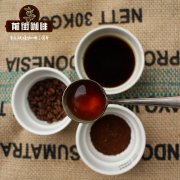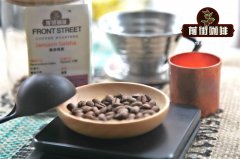Costa Rican coffee beans drink by hand micro-batch coffee beans from Genesis Manor, Costa Rica

Professional coffee knowledge exchange more coffee bean information please follow the coffee workshop (Wechat official account cafe_style)
Genesis is one of the earliest microbatch processing plants in Costa Rica and is now run by Oscar Mendes and his wife Olga. They have been producing coffee for many years, and the couple are the leaders of their community and share a lot of experience and knowledge with other farmers. Oscar and Olga buy coffee cherries from farmers in the area and process raw coffee beans at Genesis. Producers can simply pay for processing services, or they can sell their cherries to a processing plant, where the coffee processed will attach the name of the farm to the coffee for recognition.
Rich volcanic soil, sufficient sunshine, with an annual average relative humidity of 81%, abundant rainfall and an average annual temperature of 21.50 ℃, make crops grow luxuriantly in this area, and are also conducive to the cultivation of high-quality coffee at high altitude. In addition, the western valley region has a distinct dry and wet season, and when the coffee harvest season begins, it will enter the dry season, which means that the area has sufficient sunshine for washing and sunbathing. This advantage is seldom found in other producing areas in the country (almost all other famous producing areas in Costa Rica are machine-dried). The average altitude is 1000 to 1600 meters above sea level.
Kaddura, a natural variety of bourbon, was discovered in Brazil in 1937. Its tree is not as tall and shorter as bourbon. Due to inheriting the blood of bourbon, the resistance is relatively weak, but the yield is higher than that of bourbon. Although found in Brazil, Kaddura is not suitable for growing in Brazil, so it is not planted on a large scale in Brazil, but is popular in Central and South America, such as Colombia, Costa Rica and Nicaragua.
Kaduai is an artificial hybrid of Kaddura and Mondu Novo. Kaduai has a good ability to resist natural disasters, especially wind and rain. Kaduai tree species are relatively low, compared with other coffee trees, the fruit of Kaduai is stronger and harder to pick, and the fruit is both red and yellow.
The Costa Rican coffee industry started early, with the first batch of coffee shipped to Colombia and Chile as early as 1820. In 1854, an exporter, with the assistance of William Lyon, captain of the British merchant ship the Sovereign, successfully shipped 100 pounds of coffee to London, which became popular and was praised by British aristocrats as the "golden bean" from Costa Rica.
Recommended cooking method: hand grinding degree: 3.5 (Fuji R440) Water temperature: 90 °C
V60 filter cup, 15g powder, water temperature 90-91 degrees, grinding 3.5.The ratio of water to powder is close to 1:15
30 grams of water steaming, the steaming time is 30 seconds: water injection to 120ml cut off, slow water injection to 230ml
That is, 30-120-80, the total extraction time is 2 minutes. Other trickling extraction suggestions:
Normal pressure, recommended grinding degree / water temperature 90 °C Philharmonic pressure, recommended 2.5 grinding degree, water temperature 90 °C
Important Notice :
前街咖啡 FrontStreet Coffee has moved to new addredd:
FrontStreet Coffee Address: 315,Donghua East Road,GuangZhou
Tel:020 38364473
- Prev

Gold Mandolin G1 is what Gold Mandolin hand brewed coffee Flavor Taste characteristics Description
Professional coffee knowledge exchange More coffee bean information, please pay attention to coffee workshop (Weixin Official Accounts cafe_style) When it comes to gold mantinin, you have to start with PWN. This abbreviation is often mixed with the name of mantinin coffee. It is actually the abbreviation of a company, Pwani Coffee Company. This company is very famous in Indonesia.
- Next

Costa Rican tanning soul flavor Costa Rican manor black soul coffee
Professional coffee knowledge exchange more coffee bean information please follow Coffee Workshop (Wechat official account cafe_style) La Lajas Manor is located in the central valley at the foot of Pos de Alajuela volcano, managed by the Chacn family for more than 80 years, the manor is 13001500 meters above sea level, with an annual output of about 46000 jin. The annual production season of La Lajas Manor is from December to December.
Related
- Detailed explanation of Jadeite planting Land in Panamanian Jadeite Manor introduction to the grading system of Jadeite competitive bidding, Red bid, Green bid and Rose Summer
- Story of Coffee planting in Brenka region of Costa Rica Stonehenge Manor anaerobic heavy honey treatment of flavor mouth
- What's on the barrel of Blue Mountain Coffee beans?
- Can American coffee also pull flowers? How to use hot American style to pull out a good-looking pattern?
- Can you make a cold extract with coffee beans? What is the right proportion for cold-extracted coffee formula?
- Indonesian PWN Gold Mandrine Coffee Origin Features Flavor How to Chong? Mandolin coffee is American.
- A brief introduction to the flavor characteristics of Brazilian yellow bourbon coffee beans
- What is the effect of different water quality on the flavor of cold-extracted coffee? What kind of water is best for brewing coffee?
- Why do you think of Rose Summer whenever you mention Panamanian coffee?
- Introduction to the characteristics of authentic blue mountain coffee bean producing areas? What is the CIB Coffee Authority in Jamaica?

